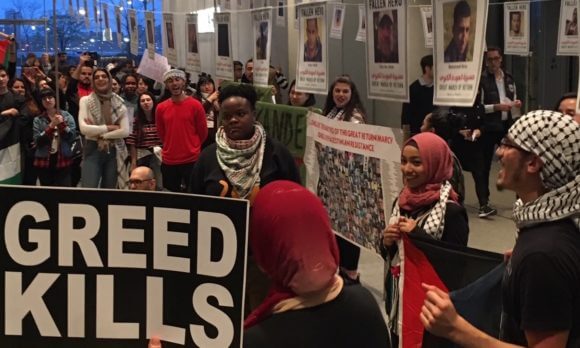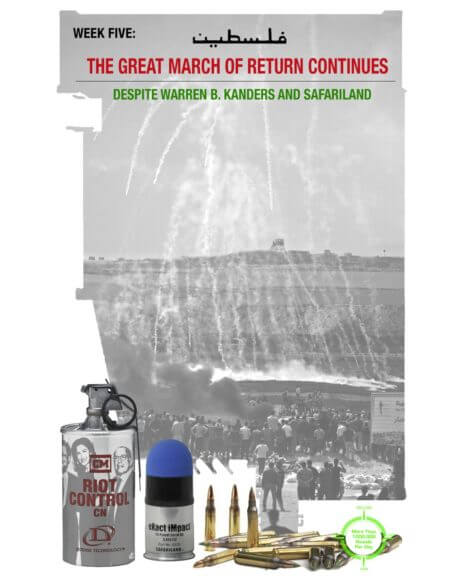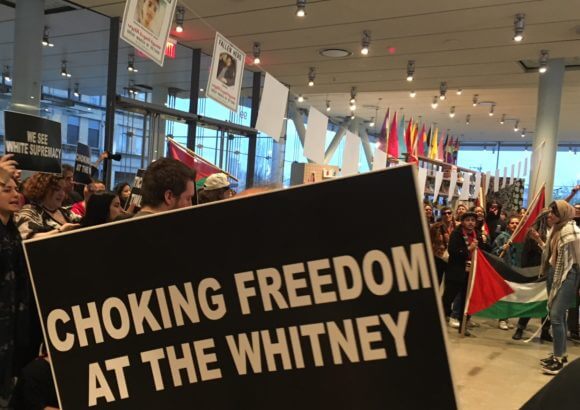New York City’s Whitney Museum of American Art is one of the most celebrated art institutions in the world. Its legendary Biennial exhibit opens on Friday. But the Whitney has a problem.
Not just a problem, a crisis, and it’s coming to a head tomorrow, May 17.
Warren B. Kanders, the vice chairmen of the board of trustees, has amassed a $700 million fortune as the CEO and majority owner of Safariland Group, a manufacturer of law enforcement gear. His company owns Defense Technology, which makes tear gas that has been deployed against unarmed civilians in Ferguson, Baltimore, Standing Rock, Puerto Rico, the U.S.-Mexico border, and in Israel/Palestine.
Calls for the war profiteer’s resignation are growing louder by the day.
“Kanders exemplifies the patterns of toxic philanthropy and artwashing that make art institutions into vehicles of oppression and violence,” says Amin Husain, one of the founding members of Decolonize this Place (DTP) the radical artist-organizer collective at the forefront of the movement to oust Kanders. “His removal is non-negotiable.”
DTP, along with scores of other grassroots art and community groups, including MTL+ Collective, Within Our Lifetime, Take Back the Bronx, Chinatown Art Brigade, launched their “9 Weeks of Art and Action” back in February. Since then, they have mounted a series of demonstrations every week at the Whitney’s Free Fridays.
“We use the lobby as a way of reclaiming these institutions,” says Kyle Goen a founding member of DTP and the artist who designs most of the group’s posters and art. “We are artists and cultural workers, and we are taking back our spaces.”
In April more than 100 artists, academics, and critics penned a letter demanding Kanders’ resignation, arguing there is an opportunity to examine artwashing in prominent cultural institutions. After it was released 49 of the 75 of the artists participating in the Biennial signed onto it and one artist has dropped out of the show.

“Warren Kanders takes the profits from state violence, funnels it into our cultural and educational institutions, then reaps the benefits of being seen as a philanthropist,” says Marz Saffore an artist, cultural critic, and DTP organizer. “If you are going to murder, displace, and dispossess our people, we’re going to continue to make your life hell.”
This round of hell-raising started last November when an article in Hyperallergic revealing the use of Kanders’ tear gas against Central American asylum-seekers at the U.S.-Mexico Border reignited a long-simmering discussion.
Three days later, more than 100 staffers at the Whitney reached out to the museum’s leadership, expressing hurt and dismay. “…we felt sick to our stomachs, we shed tears, we felt unsafe,” read their letter of protest, which included a list of demands, including considering Kanders’ resignation.
In his official reply, Kanders refused to accept responsibility for how his defense-related products are used. Until now, he has refused to resign, and the Whitney administration has declined to make further comment, including for this article.
“A lot of the Whitney staff, especially at the front of the house, are black and brown people who come from communities directly affected by this weaponry,” says Goen. “So when the museum kind of brushed them off, and told them to stay in their lane, that’s when we went into action.”
In order to amplify the staff demands, DTP organized the first of a series of public protests in the lobby of the museum on December 9, 2018. Scores of artist/organizers gathered with banners to make speeches, sing, chant, and burn sage in a symbolic gesture of cleansing, healing, and commemoration.


Since then, each protest has highlighted yet another community who has suffered from the use of Safariland tear gas. Across the range of issues—from the Indigenous struggle to Black liberation to gentrification—Palestinian liberation has occupied a central place in the narrative.
“The aesthetics of the Palestinian keffiyeh have been important for all of our actions,” says DTP member Natasha Singh. “The various groups have taken it up as a signifier that connects militant, anti-colonial movements across the world, from Puerto Rico to Standing Rock.”
On April 19, the Whitney’s lobby was packed with hundreds of pro-Palestinian protestors from many different organizations who performed debke, chanted, mic-checked, and displayed strands of fallen hero flags designed by Goen, each bearing the face of a Palestinian martyr who has lost their life in Gaza’s border protests, the Great March of Return.

Nerdeen Kiswani, a founding member of Within Our Lifetime, reminded protestors and museum visitors that it was Warren Kanders’ Safariland’s tear gas killed the eight-month-old infant Laila al-Ghandour. While the infant’s death is under investigation, it is undisputed is that Kanders has been providing munitions to the state of Israel for decades in the form of sponge-bullets and live rounds.
According to DTP, IMI Systems, the exclusive supplier of small-caliber ammunition to the Israeli army, uses Sierra Bullets in its high-powered RazorCore ammunition; Sierra Bullets is owned by the Clarus Corporation, also owned and controlled by Kanders. These weapons have killed Palestinian protesters and wounded and maimed unarmed Palestinian civilians.
And Kanders is just one of many war profiteers, the organizers say. They intend to draw attention to other board members who profit from militarism, border detention centers, surveillance systems, and other forms of state repression, wealthy donors like Nancy Carrington Crown and Pamella G. DeVos, sister-in-law of Secretary of Education Betsy DeVos.
“Removing Kanders is not an end in of itself,” says Amin Husain. “But it could be the occasion for a collective process of accountability and deep structural transformation of the institution that would need to center first and foremost the communities harmed by corporations like Safariland, setting the bar for other institutions.”

There is reason to believe that DTP and its movement collaborators can achieve some accountability. Just three weeks ago, employees and researchers at the American Museum of Natural History protested a private gala that was to have been held to honor Brazil’s far-right President Jair Bolsonaro. In this case, the museum administrators listened and canceled the event.
“This recent victory is result of three years organizing and pressure to decolonize this museum,” says Saffore, explaining DTP and MTL+’s history of protest against the insensitive and inaccurate exhibits at the AMNH.
This week, though, Decolonize this Place is focusing its attention on Kanders and the Biennial that opens Friday.
“The Whitney brand is in crisis,” says Singh. “At some point soon either Kanders himself or museum trustees and/or director Adam Weinberg will be forced to make a decision.”
Decolonize this Place and the rest of the groups are planning an evening that will be both a “culmination and an escalation,” informed by the phrase that has appeared on their banners and posters for six months:
“No Safe Space for Profiteers of State Violence.”




Brava!! Bravo!! to the protestors.
Isn’t it interesting how Merchants of Death wrap themselves in the skins of artists?